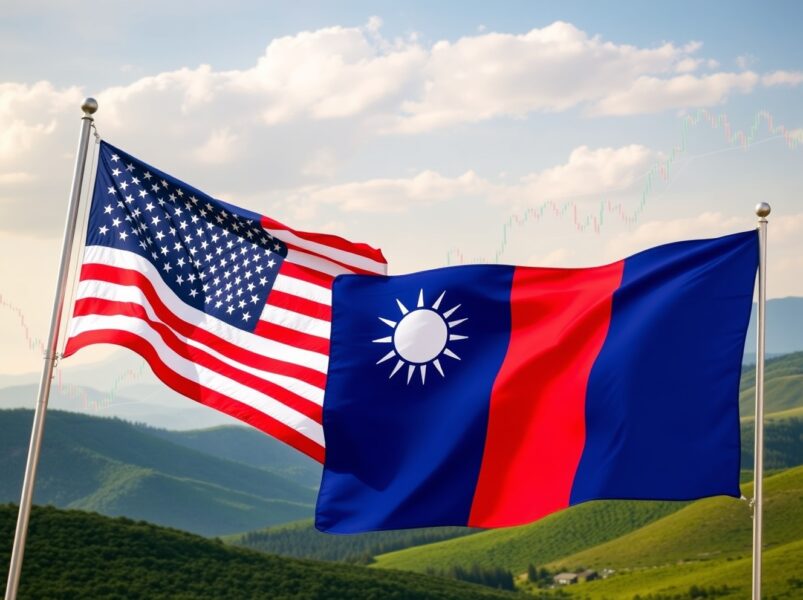Revolutionary Exchange Rate Agreement: U.S. Treasury and Taiwan Central Bank Forge Unprecedented Currency Stability Pact
0
0

BitcoinWorld
Revolutionary Exchange Rate Agreement: U.S. Treasury and Taiwan Central Bank Forge Unprecedented Currency Stability Pact
In a groundbreaking development that signals a new era of international financial cooperation, the U.S. Treasury and Taiwan Central Bank have reached a historic agreement to prevent exchange rate manipulation. This monumental pact comes at a crucial time when global currency markets face unprecedented volatility, offering hope for enhanced economic stability and transparent monetary policies.
Understanding Exchange Rate Manipulation Prevention
The agreement represents a significant step forward in combating exchange rate manipulation, a practice that has long concerned international financial markets. Both nations have committed to maintaining transparent currency policies and avoiding competitive devaluations that could disrupt global trade flows. This commitment to exchange rate manipulation prevention sets a new standard for international monetary cooperation.
U.S. Treasury’s Strategic Role in Currency Stability
The U.S. Treasury has taken a leadership position in establishing frameworks that promote fair currency practices. Through this agreement, the Treasury demonstrates its commitment to maintaining the integrity of global financial markets while supporting economic growth. The U.S. Treasury’s involvement ensures that the agreement carries significant weight in international financial circles.
| Key Agreement Components | Impact on Currency Markets |
|---|---|
| Regular consultation mechanisms | Enhanced market predictability |
| Transparency in intervention policies | Reduced speculative pressure |
| Data sharing protocols | Improved market efficiency |
Taiwan Central Bank’s Commitment to Economic Cooperation
The Taiwan Central Bank has demonstrated its dedication to responsible monetary policy through this landmark agreement. By working closely with the U.S. Treasury, the Taiwan Central Bank reinforces its position as a reliable partner in global financial governance. This economic cooperation extends beyond bilateral relations, contributing to regional financial stability.
How Will This Agreement Ensure Currency Stability?
The pact establishes clear guidelines for maintaining currency stability through several key mechanisms:
- Regular bilateral consultations on exchange rate policies
- Transparent reporting of foreign exchange interventions
- Commitment to market-determined exchange rates
- Coordination during periods of market stress
Benefits of Enhanced Economic Cooperation
This agreement fosters unprecedented economic cooperation between the two nations, creating numerous advantages:
- Reduced currency volatility for businesses and investors
- Enhanced trade and investment flows
- Improved market confidence in both currencies
- Stronger foundations for long-term economic growth
Challenges in Implementation and Monitoring
While the agreement represents significant progress, several challenges remain in ensuring effective implementation:
- Balancing domestic economic priorities with international commitments
- Monitoring compliance in rapidly changing market conditions
- Addressing potential conflicts with other trade agreements
- Ensuring transparency while protecting sensitive financial information
Actionable Insights for Forex Traders and Investors
Market participants should consider several key factors following this agreement:
- Monitor official statements from both central banks for policy guidance
- Watch for reduced volatility in USD/TWD currency pairs
- Consider long-term stability in trade-dependent sectors
- Evaluate opportunities in cross-border investments
FAQs: Understanding the Currency Agreement
What is exchange rate manipulation?
Exchange rate manipulation occurs when countries artificially influence their currency values to gain trade advantages.
Which organizations are involved in this agreement?
The agreement involves the U.S. Treasury Department and the Central Bank of the Republic of China (Taiwan).
How will this affect international trade?
The agreement promotes fair currency practices, potentially reducing trade disputes and creating more stable conditions for international commerce.
What monitoring mechanisms are in place?
Regular consultations, data sharing, and transparent reporting requirements help ensure compliance with the agreement terms.
Could this agreement serve as a model for other countries?
Yes, the successful implementation could establish a template for similar agreements between other trading partners.
Conclusion: A New Era of Financial Cooperation
This historic agreement between the U.S. Treasury and Taiwan Central Bank represents a transformative moment in international finance. By establishing clear frameworks to prevent exchange rate manipulation and promote currency stability, both nations have demonstrated their commitment to responsible economic leadership. The enhanced economic cooperation not only benefits the direct participants but also contributes to greater global financial stability. As markets adapt to this new paradigm, the agreement stands as a testament to the power of collaborative solutions in addressing complex financial challenges.
To learn more about the latest Forex market trends, explore our article on key developments shaping currency exchange rates and international monetary policy cooperation.
This post Revolutionary Exchange Rate Agreement: U.S. Treasury and Taiwan Central Bank Forge Unprecedented Currency Stability Pact first appeared on BitcoinWorld.
0
0
 Manage all your crypto, NFT and DeFi from one place
Manage all your crypto, NFT and DeFi from one placeSecurely connect the portfolio you’re using to start.




